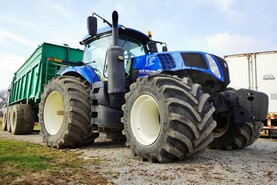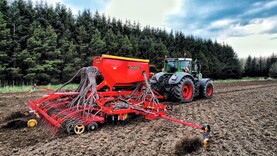Grazing and silage swards where the perennial ryegrass content has fallen to 50% to 60% is costing NI dairy farmers over £1,000/ha in terms of reduced grass yield and lost feed value.
Outlining the importance of working with young swards at last week’s reseeding demo organised by Germinal NI, AFBI researcher Dr Debbie McConnell explained that the ryegrass content of a sward will naturally decline.
While this drop can be limited to around 2% to 3% annually where swards and soil fertility are well managed, in most cases the decline is at least 5%.
Once swards reach five to six years old, the ryegrass content will have fallen to 75%. At this stage, grass yields are at best around 11t DM/ha, with energy values typically around 11.5 Mj ME/kg DM.
In comparison, new swards with 95% ryegrass will typically yield 13.5t DM/ha at 12 Mj ME under the same fertiliser regime and growing conditions. This higher yield and feed value is worth an extra £490/ha.
That is broadly similar to the cost of using minimum tillage methods to rejuvenate swards, which are in the region of up to £500/ha or £200/acre.
Therefore, once the ryegrass content of the sward dips below 75%, farmers should consider stitching in some new varieties said McConnell.
Full reseed
Older swards with ryegrass content at 50% will yield little more than 7t DM/ha when grown under the same conditions described previously.
With a higher percentage of weed grasses in such swards, the feed value is lower at 10.8 Mj ME/kg DM.
This puts the potential loss in feed value at more than £1,200/ha, which more than covers the cost of reseeding through a conventional ploughed reseed – typically £800/ha, or £320/acre.
Soil compaction
Before undertaking any reseeding project, McConnell also stressed the importance of addressing soil fertility and compaction.
Based on grazing trials, grass yields will be reduced 14% where soils have surface compaction from livestock. This increases to a 22% yield reduction where compaction has been caused by machinery.
Compact soils also hold 20% more water, which affects soil temperature and grass growth in spring and autumn.
Soil fertility
When it comes to soil fertility, 43% of NI farms are deficient in lime and 40% are deficient in potash (K). High fertiliser applications naturally make soils acidic, said McConnell.
Applying 250kg N/ha annually, or 200 units/acre, will require 1t/acre of lime to be applied every five years to neutralise the acidic effect from the outlined fertiliser programme.
Based on grass growth on GrassCheck farms across NI, soils above pH 6 grew an extra tonne of grass DM compared with soils below pH 6.
Mary McEvoy, technical manager with Germinal Ireland, outlined the best time to reseed and how to ensure new swards are established successfully.
She believes that April to early June is the optimum window when both daylight and soil temperatures are increasing. With a spring reseed there is also the option to graze during the summer, which will encourage tillering of the sward, and an opportunity to get post-emergence spray applied to control weeds.
That said, autumn reseeds can be successful if weather conditions are favourable. The aim should be to get grass seed sown out by the first week of September said McEvoy.
This will give adequate time to apply post-emergence sprays and facilitate at least one light grazing before closing for winter.
Seed bed preparation
Ideally, old swards should be burned off around two weeks ahead of reseeding.
However, if the field has a severe dock infestation, this should be controlled at least three weeks ahead of reseeding. This gives the chemicals time to kill the root system in docks which can extend to 1 metre in depth.
When burning off old leys, aim for a two-hour window of dry, calm weather to get the most effective spray application. Lime should always be applied to the seed bed as dead grass from the previous ley can turn seed beds acidic, slowing germination.
Sowing rates should be 14kg/acre and light rolling is important to ensure good soil contact, but be careful to avoid compacting or capping the soil by rolling in damp conditions.
Grass varieties
When choosing a grass mix, McEvoy said varieties in the mix should head out within 10 days of each other in grazing swards, and within seven days for silage swards.
On light, dry soils, tetraploid grasses should not exceed 35% of the total mix to avoid the sward becoming open and susceptible to weeds. Diploid varieties should be selected for heavier soils.
Controlling weeds in grass leys
Also speaking at the event, Kieran Donohoe from Clarendon Agricare outlined options for controlling weeds in grass swards. He quoted work from grazing trials which showed that reducing dock infestation resulted in increased grass yields of up to 2.6t DM/ha.
Spraying typically costs £60 to £90/ha over two years for effective dock control. Dilution rates are crucial, with between 25 and 30 gallons/acre (300 l/ha) of water required for effective weed control in grassland, applied at 2 to 3 bar of pressure.
Read more
Dairy management: grass growth set to bounce
In pictures: impressive 419-cow dairy enterprise in Co Offaly
Grazing and silage swards where the perennial ryegrass content has fallen to 50% to 60% is costing NI dairy farmers over £1,000/ha in terms of reduced grass yield and lost feed value.
Outlining the importance of working with young swards at last week’s reseeding demo organised by Germinal NI, AFBI researcher Dr Debbie McConnell explained that the ryegrass content of a sward will naturally decline.
While this drop can be limited to around 2% to 3% annually where swards and soil fertility are well managed, in most cases the decline is at least 5%.
Once swards reach five to six years old, the ryegrass content will have fallen to 75%. At this stage, grass yields are at best around 11t DM/ha, with energy values typically around 11.5 Mj ME/kg DM.
In comparison, new swards with 95% ryegrass will typically yield 13.5t DM/ha at 12 Mj ME under the same fertiliser regime and growing conditions. This higher yield and feed value is worth an extra £490/ha.
That is broadly similar to the cost of using minimum tillage methods to rejuvenate swards, which are in the region of up to £500/ha or £200/acre.
Therefore, once the ryegrass content of the sward dips below 75%, farmers should consider stitching in some new varieties said McConnell.
Full reseed
Older swards with ryegrass content at 50% will yield little more than 7t DM/ha when grown under the same conditions described previously.
With a higher percentage of weed grasses in such swards, the feed value is lower at 10.8 Mj ME/kg DM.
This puts the potential loss in feed value at more than £1,200/ha, which more than covers the cost of reseeding through a conventional ploughed reseed – typically £800/ha, or £320/acre.
Soil compaction
Before undertaking any reseeding project, McConnell also stressed the importance of addressing soil fertility and compaction.
Based on grazing trials, grass yields will be reduced 14% where soils have surface compaction from livestock. This increases to a 22% yield reduction where compaction has been caused by machinery.
Compact soils also hold 20% more water, which affects soil temperature and grass growth in spring and autumn.
Soil fertility
When it comes to soil fertility, 43% of NI farms are deficient in lime and 40% are deficient in potash (K). High fertiliser applications naturally make soils acidic, said McConnell.
Applying 250kg N/ha annually, or 200 units/acre, will require 1t/acre of lime to be applied every five years to neutralise the acidic effect from the outlined fertiliser programme.
Based on grass growth on GrassCheck farms across NI, soils above pH 6 grew an extra tonne of grass DM compared with soils below pH 6.
Mary McEvoy, technical manager with Germinal Ireland, outlined the best time to reseed and how to ensure new swards are established successfully.
She believes that April to early June is the optimum window when both daylight and soil temperatures are increasing. With a spring reseed there is also the option to graze during the summer, which will encourage tillering of the sward, and an opportunity to get post-emergence spray applied to control weeds.
That said, autumn reseeds can be successful if weather conditions are favourable. The aim should be to get grass seed sown out by the first week of September said McEvoy.
This will give adequate time to apply post-emergence sprays and facilitate at least one light grazing before closing for winter.
Seed bed preparation
Ideally, old swards should be burned off around two weeks ahead of reseeding.
However, if the field has a severe dock infestation, this should be controlled at least three weeks ahead of reseeding. This gives the chemicals time to kill the root system in docks which can extend to 1 metre in depth.
When burning off old leys, aim for a two-hour window of dry, calm weather to get the most effective spray application. Lime should always be applied to the seed bed as dead grass from the previous ley can turn seed beds acidic, slowing germination.
Sowing rates should be 14kg/acre and light rolling is important to ensure good soil contact, but be careful to avoid compacting or capping the soil by rolling in damp conditions.
Grass varieties
When choosing a grass mix, McEvoy said varieties in the mix should head out within 10 days of each other in grazing swards, and within seven days for silage swards.
On light, dry soils, tetraploid grasses should not exceed 35% of the total mix to avoid the sward becoming open and susceptible to weeds. Diploid varieties should be selected for heavier soils.
Controlling weeds in grass leys
Also speaking at the event, Kieran Donohoe from Clarendon Agricare outlined options for controlling weeds in grass swards. He quoted work from grazing trials which showed that reducing dock infestation resulted in increased grass yields of up to 2.6t DM/ha.
Spraying typically costs £60 to £90/ha over two years for effective dock control. Dilution rates are crucial, with between 25 and 30 gallons/acre (300 l/ha) of water required for effective weed control in grassland, applied at 2 to 3 bar of pressure.
Read more
Dairy management: grass growth set to bounce
In pictures: impressive 419-cow dairy enterprise in Co Offaly






 This is a subscriber-only article
This is a subscriber-only article









SHARING OPTIONS: